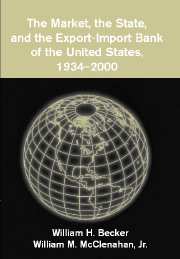Book contents
- Frontmatter
- Contents
- Preface and Acknowledgments
- Introduction
- 1 Setting a Flexible Course: The Export-Import Bank, 1934–1939
- 2 World War and Its Aftermath
- 3 Cold War and the Needs of a New Era, 1948–1961
- 4 Becoming “Two Institutions”
- 5 New Mandates and New Limits
- 6 Turmoil and Turning Points
- 7 A New Era and Its Challenges, the 1990s
- Epilogue
- Appendix A Board of Directors
- Appendix B Summary of Authorizations
- Appendix C Number of Authorizations
- Appendix D Charges Against Statutory Limitations on Total Activity
- Index
5 - New Mandates and New Limits
Published online by Cambridge University Press: 13 July 2009
- Frontmatter
- Contents
- Preface and Acknowledgments
- Introduction
- 1 Setting a Flexible Course: The Export-Import Bank, 1934–1939
- 2 World War and Its Aftermath
- 3 Cold War and the Needs of a New Era, 1948–1961
- 4 Becoming “Two Institutions”
- 5 New Mandates and New Limits
- 6 Turmoil and Turning Points
- 7 A New Era and Its Challenges, the 1990s
- Epilogue
- Appendix A Board of Directors
- Appendix B Summary of Authorizations
- Appendix C Number of Authorizations
- Appendix D Charges Against Statutory Limitations on Total Activity
- Index
Summary
INTRODUCTION
There were momentous changes in the international economy in the 1970s, an altered environment that heavily impacted the Bank. The institutional arrangements and the “rules of the game” that had structured international economic activity since the end of World War II were undone in the 1970s. U.S. trade and payments surpluses turned into deficits, which among other things accelerated pressures to devalue the dollar. Consequently, in August 1971, President Richard M. Nixon abandoned the gold-backed, dollar-based fixed exchange rate system established at Bretton Woods in 1944. Its demise was followed by a depreciation of the dollar against major currencies, and ultimately a system of floating exchange rates. In 1973–4, the Organization of Petroleum Exporting Countries (OPEC) delivered the first of its oil shocks by quadrupling per barrel petroleum prices. One immediate consequence was increasing inflation and higher interest rates in the industrialized world and hardship in the developing countries. Most countries importing oil believed they needed to stimulate exports to counter the negative impact of OPEC prices on their balance of payments. Over the longer term, the recycling of “petrodollars” distorted international capital flows, which set the stage for the debt crisis of the 1980s.
These changes helped end the favorable economic conditions in the United States in the 1960s. The American economy gave way to slower growth, lower profits, and higher levels of inflation and unemployment in the 1970s.
- Type
- Chapter
- Information
- Publisher: Cambridge University PressPrint publication year: 2003

